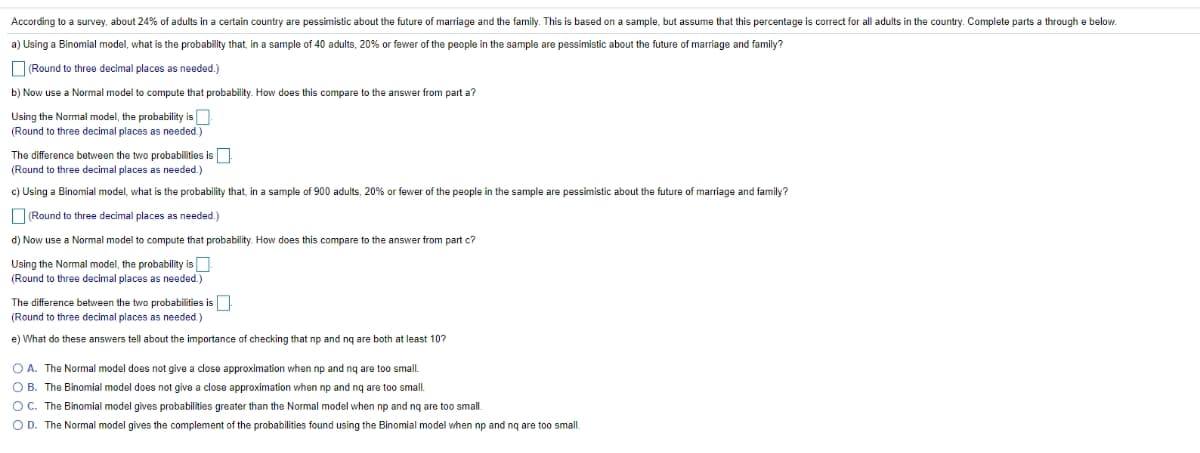According to a survey, about 24% of adults in a certain country are pessimistic about the future of marriage and the family. This is based on a sample, but assume that this percentage is correct for all adults in the country. Complete parts a through e below. a) Using a Binomial model, what is the probability that, in a sample of 40 adults, 20% or fewer of the people in the sample are pessimistic about the future of marriage and family? ORound to three decimal places as needed.) b) Now use a Normal model to compute that probability. How does this compare to the answer from part a? Using the Normal model, the probability is (Round to three decimal places as needed.) The difference between the two probabilities is (Round to three decimal places as needed.) c) Using a Binomial model, what is the probability that, in a sample of 900 adults, 20% or fewer of the people in the sample are pessimistic about the future of marriage and family? O(Round to three decimal places as needed.) d) Now use a Normal model to compute that probability How does this ar from part c?
According to a survey, about 24% of adults in a certain country are pessimistic about the future of marriage and the family. This is based on a sample, but assume that this percentage is correct for all adults in the country. Complete parts a through e below. a) Using a Binomial model, what is the probability that, in a sample of 40 adults, 20% or fewer of the people in the sample are pessimistic about the future of marriage and family? ORound to three decimal places as needed.) b) Now use a Normal model to compute that probability. How does this compare to the answer from part a? Using the Normal model, the probability is (Round to three decimal places as needed.) The difference between the two probabilities is (Round to three decimal places as needed.) c) Using a Binomial model, what is the probability that, in a sample of 900 adults, 20% or fewer of the people in the sample are pessimistic about the future of marriage and family? O(Round to three decimal places as needed.) d) Now use a Normal model to compute that probability How does this ar from part c?
Holt Mcdougal Larson Pre-algebra: Student Edition 2012
1st Edition
ISBN:9780547587776
Author:HOLT MCDOUGAL
Publisher:HOLT MCDOUGAL
Chapter11: Data Analysis And Probability
Section11.8: Probabilities Of Disjoint And Overlapping Events
Problem 2C
Related questions
Question

Transcribed Image Text:According to a survey, about 24% of adults in a certain country are pessimistic about the future of marriage and the family. This is based on a sample, but assume that this percentage is correct for all adults in the country. Complete parts a through e below.
a) Using a Binomial model, what is the probability that, in a sample of 40 adults, 20% or fewer of the people in the sample are pessimistic about the future of marriage and family?
ORound to three decimal places as needed.)
b) Now use a Normal model to compute that probability. How does this compare to the answer from part a?
Using the Normal model, the probability is
(Round to three decimal places as needed.)
The difference between the two probabilities is
(Round to three decimal places as needed.)
c) Using a Binomial model, what is the probability that, in a sample of 900 adults, 20% or fewer of the people in the sample are pessimistic about the future of marriage and family?
O(Round to three decimal places as needed.)
d) Now use a Normal model to compute that probability How does this
ar from part c?
Expert Solution
This question has been solved!
Explore an expertly crafted, step-by-step solution for a thorough understanding of key concepts.
This is a popular solution!
Trending now
This is a popular solution!
Step by step
Solved in 2 steps

Knowledge Booster
Learn more about
Need a deep-dive on the concept behind this application? Look no further. Learn more about this topic, statistics and related others by exploring similar questions and additional content below.Recommended textbooks for you

Holt Mcdougal Larson Pre-algebra: Student Edition…
Algebra
ISBN:
9780547587776
Author:
HOLT MCDOUGAL
Publisher:
HOLT MCDOUGAL


Holt Mcdougal Larson Pre-algebra: Student Edition…
Algebra
ISBN:
9780547587776
Author:
HOLT MCDOUGAL
Publisher:
HOLT MCDOUGAL
